Blue light concerns for gamers
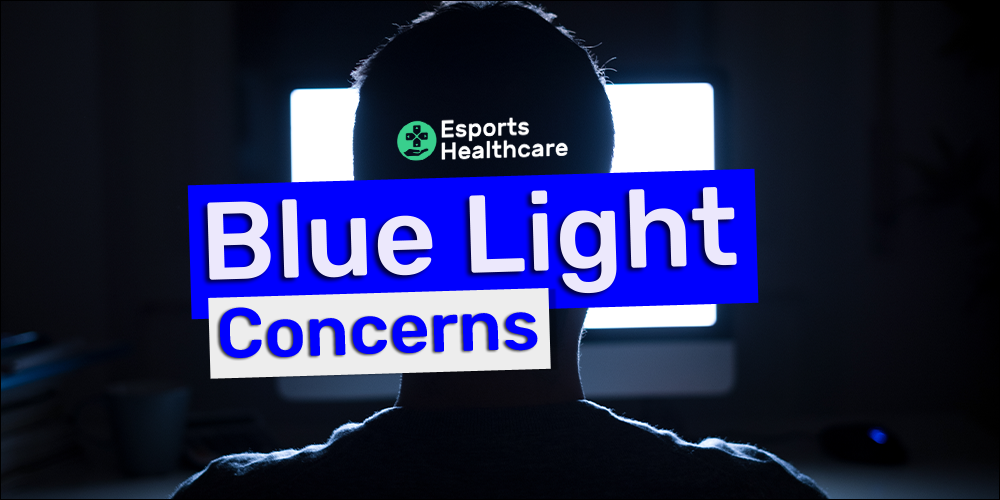
Key points
Disclaimer
This information is for educational purposes only and is not intended to replace the advice of your doctor. Esports Healthcare disclaims any liability for the decisions you make based on this information.
The information contained on this website does not establish, nor does it imply, doctor-patient relationship. Esports Healthcare does not offer this information for diagnostic purposes. A diagnosis must not be assumed based on the information provided.
With the growing use of light-emitting diodes (LEDs), concern has risen over the negative health effects of the increased exposure to blue light. In this post, we explain everything you need to know about blue light, how it affects your brain, and what you can do to limit potential side-effects.
What is light?
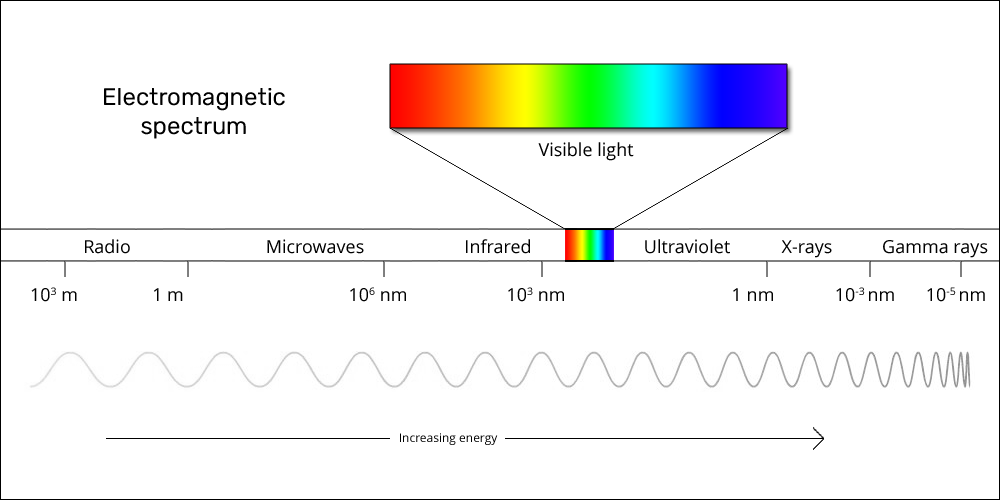
Electromagnetic spectrum of light
Light is energy emitted in the form of electromagnetic waves as they radiate out across the universe. This energy can be described by the spectrum of light, as seen above. While all energy is the same, this spectrum can be broken down into sub-categories of waves depending on how they interact with matter.
These waves can be placed into seven unique categories:
- Radio
- Microwave
- Infrared
- Visible
- Ultraviolet
- X-ray
- Gamma ray.
Radio waves have the least energy but the largest wavelength, extending as far as thousands of kilometers (km, or one thousand meters). On the opposite end of the light spectrum, gamma rays have the most energy, yet have wavelengths in the picometer (abbreviated pm, which is one trillionth of a meter) range.
Visible light
Somewhere near the middle, and as evidenced by its name, visible light is the only portion of the light spectrum that can be seen by the naked eye.
Between 380 and 700 nanometers (abbreviated nm, which is one millionth of a meter), lies the visible light spectrum. While it does not contain all of the colors that the brain can perceive, the spectrum does contain the spectral colors, or the colors of the rainbow. Visible light ranges from the lowest energy, longest wavelength red light to the highest energy, shortest wavelength violet light.
Blue light
When we use the term “blue light” in reference to potential side-effects, we are identifying the wavelength range of visible light that appears blue, which will also contain visible violet light. We define high-energy, visible blue light as the wavelengths between 380-495 nm.1 This means that, by definition, over one-third (>33%) of all visible light is actually blue light!
When light of different wavelengths enters the eye, specialized cells convert this energy into electrical signals. Most of these signals then travel to the visual cortex of the brain where they produce the images you see.
The eye and photoreception
Photoreception is the conversion of light energy into biological signals within the body. This process occurs in the retina, a thin layer of nerve tissue in the back of the eye. The retina contains three types of light-sensitive cells:
- Rods
- Cones
- Intrinsically photosensitive retinal ganglion cells (ipRGCs)
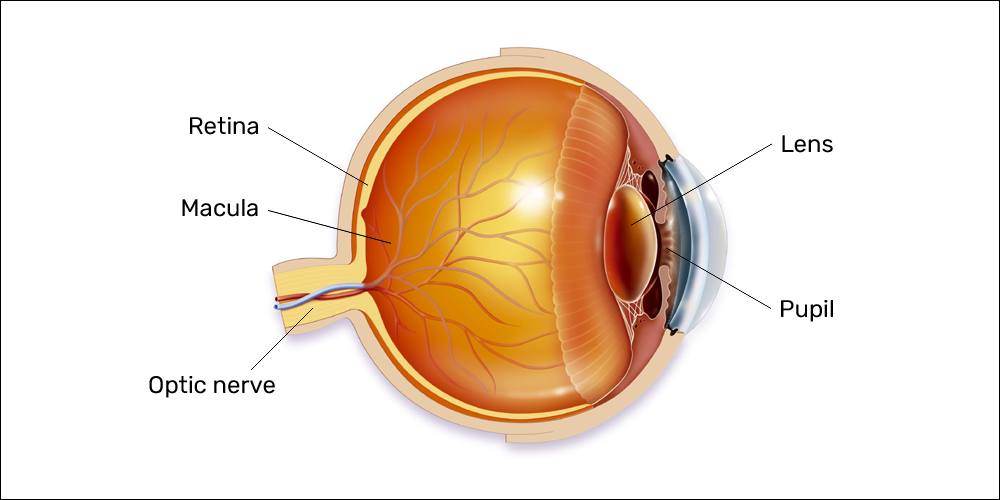
The two more commonly known photoreceptors, rods and cones, are responsible for image-forming vision and play a prominent role in our ability to see. Conversely, the more recently discovered ipRGCs are responsible for non-image-forming photoreception.2,3,4,5,6
While these cells don’t contribute directly to our sense of vision, they play an important role in other biological functions. These include affecting alertness and the pupils’ response to light, while also controlling the body’s circadian rhythm (our 24-hour sleep-wake cycle).
When light activates these specialized receptors, an electric signal is sent to the pineal gland of the brain. There, it is able to control the body’s circadian rhythm through the release of the hormone melatonin.
When light activates the ipRGC receptors in the retina, an electric signal is sent through the retinal hypothalamic tract. It then travels to the suprachiasmatic nucleus, a small region on the hypothalamus of the brain, where it is able to relay this information to the pineal gland. There, it is finally able to control the release of the hormone melatonin.
Melatonin and the pineal gland
Melatonin, commonly known as the sleep hormone, is produced by the pineal gland of the brain. This hormone helps the body to regulate its circadian rhythm (sleep-wake cycle), allowing for consistent and quality sleep each night.
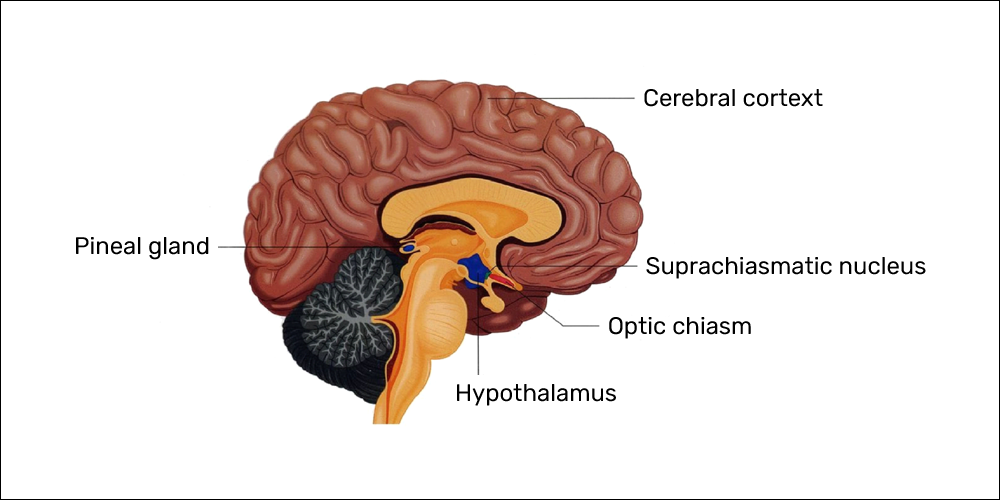
Sleep is one of the most important biological functions and is necessary for optimal health and performance. Proper sleep allows for detoxification of the body, mental organization of information, and decreasing the risk of all-cause mortality. For more information about the importance of sleep, check out our page on sleep.
The amount of melatonin released from the pineal gland is linked directly to light and darkness, with light inhibiting production of the hormone. This means that melatonin levels are low during the day when the body is active, and high at night when the body is preparing to sleep.
This process starts with the light-sensitive ipRGC cells in the eyes. When daytime light reaches the eye, these cells are activated and a signal is sent to lower melatonin levels. Light from the sun contains all wavelengths across the visible light spectrum, but different wavelengths (different colors) have different levels of effect on melatonin.
Blue light has been found to cause the largest melatonin suppression, with the most powerful wavelengths peaking at 479 nm,5 and extending down to 446 nm.3,7 Other research has found significant melatonin suppression with blue-green light at 497 nm and even green light at 525 nm.8
Since these wavelengths are most present during the day, the body’s circadian rhythm was easily aligned with the earth’s 24-hour light cycle when the only source of light was the sun. With the growing use of light-emitting diodes, however, this light-dark cycle has become commonly disrupted.
Light-emitting diodes and melatonin suppression
Light-emitting diodes (LEDs) have become widely used because of their lower energy consumption, longer lifespan, and smaller size as compared to older incandescent and fluorescent lighting.4 Due to these benefits, they have become a primary lighting source for not just general illumination but also TVs, computers, tablets, and smart phones.
LEDs produce white light through a process known as solid-state lighting. This is achieved by combining a blue LED light with peak emissions between 450 and 470nm (within the most powerful range and most often at 460nm), and a yellow phosphor.2,4,9
This means that although the bright light coming from your screens may appear as white light, it is actually mostly blue light! This issue only gets worse as the LEDs age over time, as the phosphor becomes less efficient and more blue light is emitted.2
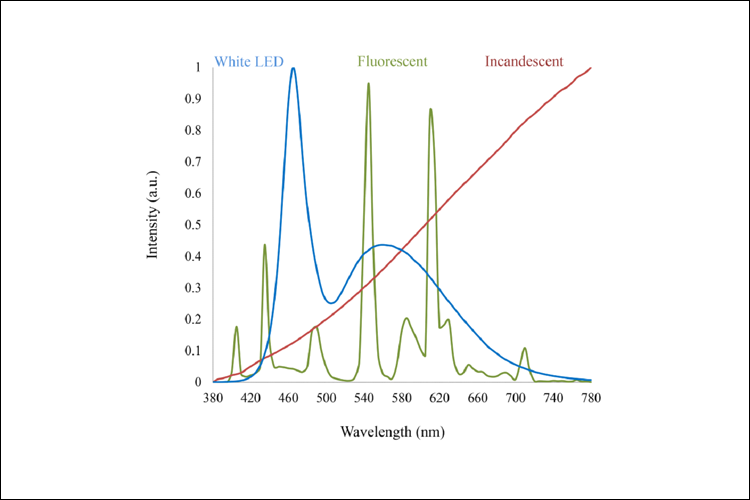
Above, the graph shows the power spectrums of a standard white-light LED (in blue), a tri-color fluorescent lamp (in green), and an incandescent source (in red). The white-light LED has the highest level of blue light emission, mostly around 460nm. Although the three lights may appear similar to the naked eye, they all have drastically different wavelengths and, therefore, different effects on the body.
As stated earlier, blue light between 446 and 479 nm is the most powerful melatonin suppressor. This range overlaps with the 460 nm blue light produced by the common LED device, and thus a problem arises.
When the artificial blue light activates the receptor cells in the eyes, the brain suppresses melatonin as if it was daytime. Nighttime use of LED devices, such as smartphones or TVs, can have a harmful effect on both sleep and the body’s circadian rhythm.
One study found the use of an eBook device before bedtime lowers melatonin levels by over 50% while also reducing evening sleepiness and next morning alertness.10 According to the American Medical Association, exposure to excessive light at nighttime can disrupt sleep and exacerbate sleep disorders, especially in children and adolescents.6
While sleep is associated with circadian rhythm, it is only one component of a larger group of biological functions. Nighttime use of LED devices not only disrupts sleep but can also delay the body’s biological clock resulting in widespread problems.
It has been found that circadian rhythm disturbances may increase the chances of certain types of cancer, especially breast cancer, while also worsening symptoms of depression and mood disorders, obesity, diabetes, and reproductive problems.4,6 Additionally, these circadian delays can lead to impaired mood, focus, and alertness, in addition to decreased performance.3
Additional concerns with blue light
Although the main problem with prolonged blue light exposure is its negative effect on sleep and circadian rhythm, additional health concerns do exist. These high energy short waves are more powerful than other colors and can penetrate deeper into the tissues of the eye. This can result in eye discomfort and may potentially contribute to eye damage.
Eye discomfort
Eye discomfort from screen time is usually attributed to eye strain caused by staring at a limited field of gaze with a static depth for an extended time. The LED light, however, can also contribute to eye discomfort.

Blue light has been found to increase free radical production on the surface of the eye, resulting in inflammation and dry eye symptoms.11,12 The condition called dry eyes is more than just lack of moisture on the surface of the eyeball.
Symptoms of dry eyes may include:
- Stinging or burning
- Sensitivity to light
- Redness of the sclera (the white part of the eye)
- Straining nighttime vision
- Blurred vision
Additionally, blue light can worsen symptoms of visual fatigue and nearsightedness. This can make it difficult to concentrate which can affect learning and working efficiency.12
Eye damage
A commonly held concern about exposure to blue light from LEDs is the possibility of eye damage. This “blue light hazard” is the ability of high energy, short light waves to cause injury to the retina and other structures of the eye.
According to the International Commission on Non-Ionizing Radiation Protection (ICNIRP), all light can affect the retina, but the peak effectiveness of the injury is between 435 and 440 nm. The ICNIRP identifies, however, that the blue light produced by common LEDs does not contribute to blue light hazard and is “not-of-concern” in terms of safety.9
As stated earlier, the peak emissions of blue light from LEDs are between 450 to 470 nm, placing them out of the dangerous wavelength range associated with blue light hazard. The International Commission on Illumination (CIE), another committee dealing with light safety, states “there is no evidence in humans of any adverse health effects from occasional exposure to optical radiation at the exposure limits.”13
It is also important to note that studies suggesting blue light from LEDs can cause macular degeneration or cataracts are performed in unusual conditions. These include higher energy blue light, abnormal fixation on the light source, and the use of rats for the studies—the latter of which makes it difficult to extrapolate the results to humans, especially from nocturnal animals with different eye anatomies. Ultimately, these forms of research analysis provide unclear results.2,9,13
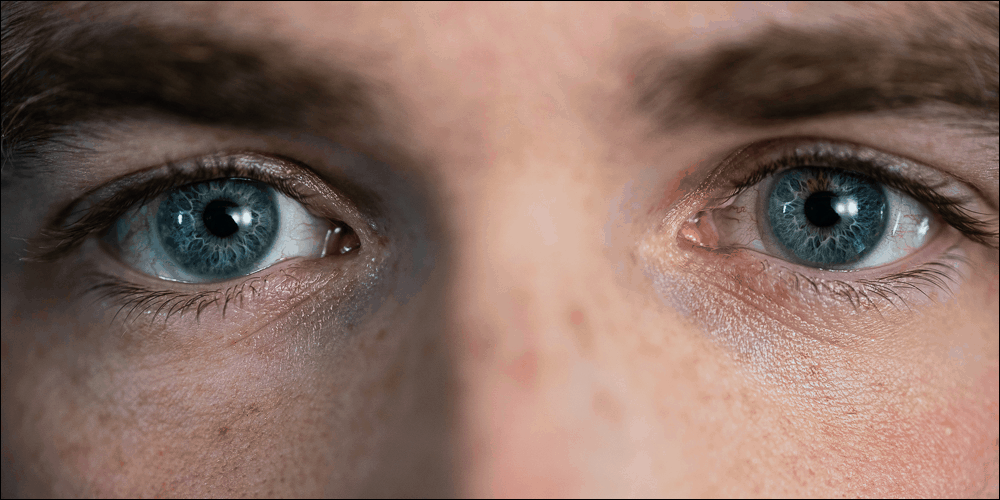
The benefit of blue light
In certain situations, blue light can be beneficial. Blue light has been found to increase alertness and vigilance, stimulate cognitive function, and even help treat seasonal affective disorder.2,4 While blue light at night disrupts the circadian rhythm, blue light during the day reinforces the body’s internal clock through a process known as entrainment.2,3,7,14
The trouble with blue light arises when people are exposed to it at incorrect times. Thankfully, this issue can be managed in a few ways.
How to reduce blue light
The main sources of blue light after sundown are the LED devices that are so prevalent in the world today. However, for gamers, completely avoiding TVs, computers, tablets, and smart phones is an impractical solution.
With the increased awareness of the harmful effects of nighttime blue light, companies have developed counter measures to lower this exposure. The two most effective ways to limit blue light are through blue light blocking glasses and blue light filters on LED devices.
Blue light filter applications
Most LED monitors, smart phones, and tablets have filter options to limit the blue light displayed on the devices. These blue light filters can usually be found in the device’s display settings.
- Windows 10: the setting is called Night light
- Android devices: the option is simply called Blue Light Filter
- Apple products: this feature is known as Night Shift
These options decrease the blue light emitted from the devices and limit their negative effects on sleep and circadian rhythm as well as symptoms of eye discomfort.
Blue light blocking glasses
Blue light blocking glasses have become a popular item to counteract the constant exposure to blue light from LED devices. As evident by their name, these glasses can block specific wavelengths of light.
Blue light blocking glasses have been found to reduce melatonin suppression, increase sleep quality and duration, improve mood and visual comfort, and can help alleviate symptoms of eye strain.15,16,17
They may also offer relief to those who suffer from insomnia18 and delayed sleep phase disorder19.
Not all blue light blocking glasses are the same however, and not all are helpful. When looking for an effective pair of glasses, it is important to know which specific wavelengths are being filtered and the percentage of these wavelengths that are actually blocked.
Wavelength
As described above, blue light between 446 and 479 nm is the strongest melatonin suppressor, and around 460 nm is the peak wavelength emitted from LED devices. If your blue light blocking glasses do not block these wavelengths, they will not be as effective as others!
Many blue light glasses companies will target the 400 to 420 nm range. While these wavelengths are certainly more dangerous, they are not emitted by your smartphones, monitors, and other LED devices.
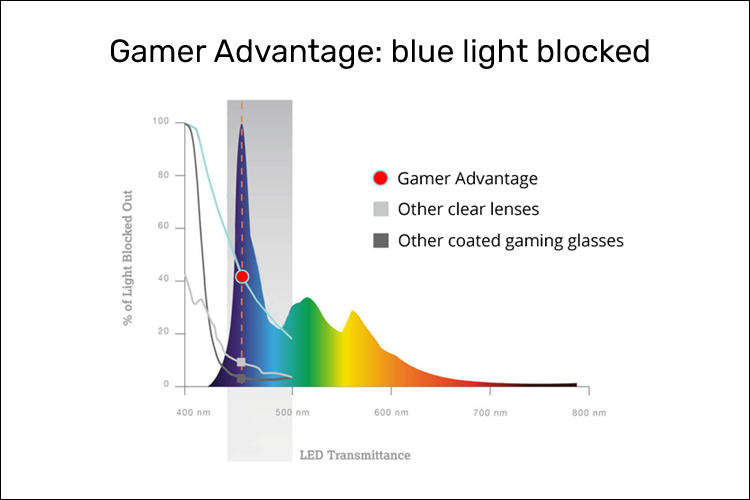
Light filtered
A key property of blue light blocking glasses is how much light is filtered by the lenses. This amount is defined by two different terms: light transmitted and light blocked.
Light transmitted refers to light that can pass through the lens, while light blocked refers to light that cannot pass through the lens. As you can see, these are opposing terms!
You will want to find blue light blocking glasses that transmits less than 70% of blue light. If you use the opposing terminology, you want glasses that block more than 30% of blue light. Information on both can be found by contacting the company that makes the glasses and asking them for a spectrum report.
Gamer Advantage blue light glasses
Through our research of blue light blocking glasses, we recommend Gamer Advantage. Their clinically tested glasses target the 455 nm wavelength of blue light, filtering out 42% of the most powerful melatonin-suppressing waves emitted by the common LED device.
Why Gamer Advantage?
Gamer Advantage uses near-clear lenses to avoid color distortion, and double sided anti-reflective coating to reduce glare.
A survey of over 2,000 patients wearing the glasses had the following results:
- 99.1% eyes more relaxed indoors
- 98.2% significant sleep improvement
- 96% increase in melatonin levels
- 93.8% absolute “yes” to wear as everyday glasses
- 65.1% significant reduction in tension-type headaches and migraine headaches
As part of maintaining optimal sleep hygiene, Gamer Advantage’s glasses can help to reduce the negative effects of LED blue light.
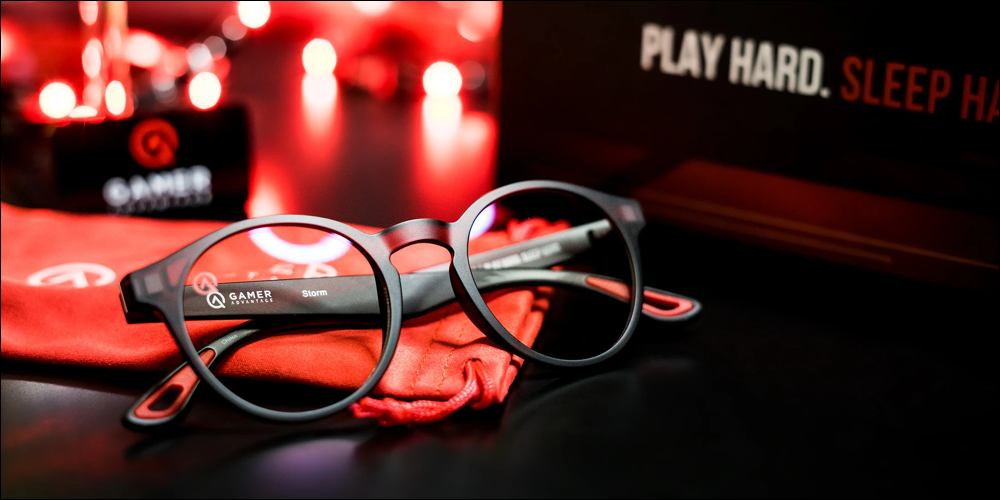
Get your Gamer Advantage glasses today!
In coordination with Gamer Advantage, we will continue to provide educational material regarding eye health, and an additional benefit to you, our viewers, of this coordinated effort is a discount on Gamer Advantage products. Head on over to their website, and use code HEALTH to receive 15% off!
References
- https://www.allaboutvision.com/cvs/blue-light.htm
- Tosini G, Ferguson I, Tsubota K. Effects of blue light on the circadian system and eye physiology. Molecular Vision. 2016; 22:61-72.
- West KE, Jablonski MR, et al. Blue light from light-emitting diodes elicits a dose-dependent suppression of melatonin in humans. J Appl Physiol. 2011; 110:619-26.
- Hatori M, Gronfier C, et al. Global rise of potential health hazards caused by blue light induced circadian disruption in modern aging societies. npj Aging and Mechanisms of Disease. 2017; 3(9):1-3.
- Bailes HJ, Lucas RJ. Human melanopsin forms a pigment maximally sensitive to blue light (λmax≈479 nm) supporting activation of Gq/11 and Gi/o signalling cascades. Proc R Soc B. 2013; 280:20122987.
- Council on Science and Public Health Report 4. Light pollution: Adverse health effects of nighttime lighting. American Medical Association House of Delegates Annual Meeting. June 2012, Chicago, IL.
- Brainard GC, Hanifin JP, et al. Action spectrum for melatonin regulation in humans: Evidence for a novel circadian photoreceptor. Journal of Neuroscience. 2001; 21(16):6405-12.
- Wright HR, Lack, LC. Effect of light wavelength on suppression and phase delay of the melatonin rhythm. Chronobiology International. 2001; 18(5): 801-8.
- International Commission on Non-Ionizing Radiation Protection. Light-emitting diodes (LEDS): Implications for safety. Health Phys. 2020; 118(5):5490561.
- Chang Am, Aeschbach D, Duffy JF, Czeisler CA. Evening use of light-emitting eReaders negatively affects sleep, circadian timing, and next-morning alertness. PNAS. 2015; 112(4):1232-7.
- Lee HS, Cui L, et al. Influence of light emitting diode-derived blue light overexposure on mouse ocular surface. PloS one. 2016; 11(8).
- Zhao ZC, Zhou Y, Tan G, Li J. Research progress about the effect and prevention of blue light on eyes. Int J Ophthalmol. 2018; 11(12):1999-2003.
- Nield K. CIE position statement on the blue light hazard. Color Research and Application. 2019; 44(4):672-3.
- Berson DM, Dunn FA, Takao M. Phototransduction by retinal ganglion cells that set the circadian clock. Science. 2002; 295(5557): 1070-3.
- Burkhart K, Phelps JR. Amber lenses to block blue light and improve sleep: A randomized trial. Chronobiology International. 2009; 26(8):1602-12.
- van der LelyS, Frey S, et al. Blue blocker glasses as a countermeasure for alerting effects of evening light-emitting diode screen exposure in male teenagers. J Adolesc Health. 2015; 113-9.
- Zhao HL, Jiang J, Yu J, Xu HM. Role of short-wavelength filtering lenses in delaying myopia progression and amelioration of asthenopia in juveniles. Int J Ophthalmol. 2017; 10(8):1261-7.
- Shechter A, Kim EW, St-Onge MP, Westwood AJ. Blocking nocturnal blue light for insomnia: A randomized controlled trial. J Psychiatr Res. 2018; 96:196-202.
- Esaki Y, Kitajima T, et al. Wearing blue light-blocking glasses in the evening advances circadian rhythms in the patients with delayed sleep phase disorder: An open-label trial. Chronobiology International. 2016; 33(8):1037-44.
- Gamer Advantage: https://gameradvantage.com
